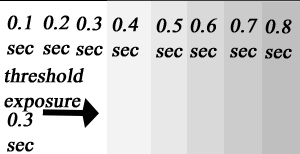Paper Exposure
Flashing
When trying to print very tricky neg's that have contrasty areas that are broken into tiny areas, like sun sparkling on water, it can be impossible to get any texture in the highlights while retaining the desired tone in the denser area around the sparkling points of light. By flashing the emulsion with an over all light to just below the base threshold ( the threshold is the amount of light needed to produce the slightest tone on the paper) any extra exposure through the neg will register as a tone and will fill in all the small points other wise undodgeable. The flashing exposure for a print has to be calculated by making a test strip with no neg in the holder in steps of about 1/10 sec up to 1 sec. The correct flashing exposure is the one just before the first tone is registered on the paper once it has been developed.

For some strange reason, there is a difference between pre and post fogging on the final image. With pre fogging the while the highlights are filled in, the dense tones are lowered and show more detail. While with post fogging the highlights are filled just the same but the dense areas will hold their tone. The effect is equivalent to lowering the grade of the paper by about a 1/2 grade.